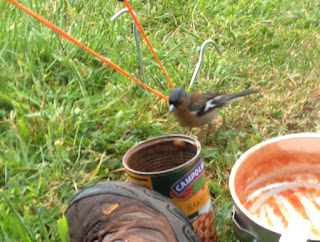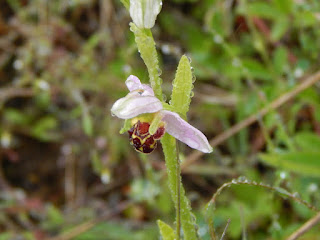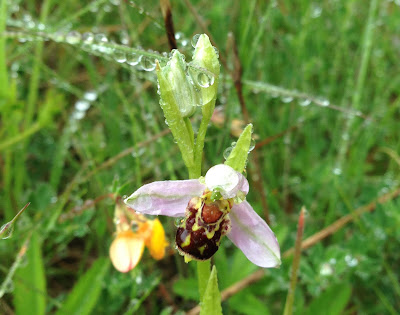 |
| A very friendly Chaffinch joining us for breakfast |
I will come back to How Stean another day but I want to focus on what I think is a pretty little flower that I had never seen before today. As I said above, I saw it at Nosterfield LNR reserve where I actually went looking for Bloody Nosed Beetles. Sadly, as I also said above, it was a rather cold, rainy day and there weren't any around. But most flowers are open whatever the weather just like this lovely orchid. As you'll know from the alliterative appellation (title) today I am covering Bee Orchids.
So, I present to you, The Facts!
 |
| Bee Orchid (Ophrys apifera) |
- This plant is actually quite clever. The reason it's called a Bee Orchid is that it's got a petal that looks like a bee resting on the plant.
- This is clever for two reasons:
- It smells like a female bee does.
- The Male Bee will come and try to mate with the Bee but instead, pollinate the flower!
- In most species of this plant the Male Bees that land become covered in pollen which, in turn, pollinate the flowers he visits next.
- Sadly, the kind of Bee that does this doesn't occur in the UK so our Bee Orchids are self-pollinating. :-(
 |
| Glistening in the rain |
- They actually only occur in June and July. June is when the flowers come out and blossom and July is when they pollinate themselves. The rest of the year they cannot be seen...
- Nosterfield is one of the only places in North Yorkshire to see them as it has the best habitat. As Nosterfield is a Quarried Area, it needs to have something special and here, that's limestone.
- Yes, the ideal habitat for Bee Orchids includes limestone rich grassy areas. Exactly what they need as they are found on 'semi-dry turf'', grasslands, limestone areas, calcareous dunes and clearings in woods.
- The Bee Orchid is a protected species in Northern Ireland as its number have decreased there but it is pretty stable in England and seems to be spreading North.
 |
| A very pretty flower even on a dull damp day. |
- The flower had a place in the Roman world too, so a Roman historian Pliny the Elder tells us. Roman ladies used to use it to darken their eyebrows.
- One final word on the Bee Orchid. It is the county flower, such as the North Yorkshire White Rose, of Bedfordshire.
Here are some links to some more information:
Hope you enjoyed,
Z.
Such beautiful flowers - lovely post Zach! - Tasha
ReplyDelete